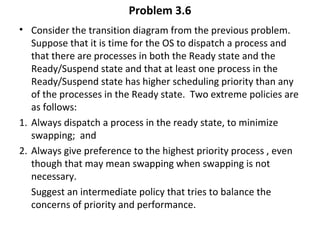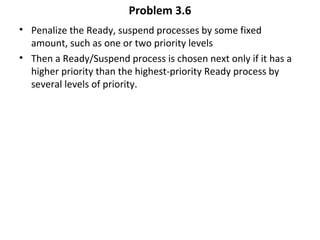Homework solution1
- 1. Problem 2.1 • Suppose we have a multiprogrammed computer in which each job has identical characteristics. In one computation period, T, for a job, half the time is spent in I/O and the other half in processor activity. Each job runs for a total of N periods. Assume that a simple round-robin scheduling is used, and that I/O operations can overlap with processor operation. Define the following quantities: • Turnaround time = actual time to complete a job • Throughput = average junber of jobs completed per time period T • Processor utilization = percentage of time that the processor is active (not waiting) • Compute these quantities for one, two and four simultaneous jobs, assuming the period T is distributed in each of the following ways: (a) I/O first half, processor second half (b) I/O first and fourth quarter, processor second and fourth quarter.
- 2. Problem 2.1 • Each process uses the first half of the time period T to do IO • Then in second half, uses the processor • Process needs N time periods to complete • One process:
- 3. Problem 2.1 • Each process uses the first half of the time period T to do IO • Then in second half, uses the processor • Process needs N time periods to complete • Two proceses:
- 4. Problem 2.1 • Each process uses the first half of the time period T to do IO • Then in second half, uses the processor • Process needs N time periods to complete • Two procesess:
- 5. Problem 3.3 Possible transitions (pages 123-124): • New → Ready or Ready/Suspend • Ready → Running or Ready/Suspend • Ready/Suspend → Ready • Blocked → Ready or Blocked/Suspend • Blocked/Suspend → Ready /Suspend or Blocked • Running → Ready, Ready/Suspend, or Blocked • Any State → Exit a. List all possible transitions and give an example of what could cause each.
- 6. Problem 3.3 Impossible transitions: • New → Blocked, Blocked/Suspend, or Running: A newly created process remains in the new state until the processor is ready to take on an additional process, at which time it goes to one of the Ready states. • Ready → Blocked or Blocked/Suspend: Typically, a process that is ready cannot subsequently be blocked until it has run. Some systems may allow the OS to block a process that is currently ready, perhaps to free up resources committed to the ready process. • Ready/Suspend → Blocked or Blocked/Suspend: Same reasoning as preceding entry. b. List all impossible transitions and explain why they cannot occur
- 7. Problem 3.3 • Ready/Suspend → Running: The OS first brings the process into memory, which puts it into the Ready state. • Blocked → Ready /Suspend: this transition would be done in 2 stages. A blocked process cannot at the same time be made ready and suspended, because these transitions are triggered by two different causes. • Blocked/Suspend → Ready: same reasoning as Blocked → Ready /Suspend b. List all impossible transitions and explain why they cannot occur
- 8. Problem 3.6 • Consider the transition diagram from the previous problem. Suppose that it is time for the OS to dispatch a process and that there are processes in both the Ready state and the Ready/Suspend state and that at least one process in the Ready/Suspend state has higher scheduling priority than any of the processes in the Ready state. Two extreme policies are as follows: 1. Always dispatch a process in the ready state, to minimize swapping; and 2. Always give preference to the highest priority process , even though that may mean swapping when swapping is not necessary. Suggest an intermediate policy that tries to balance the concerns of priority and performance.
- 9. Problem 3.6 • Penalize the Ready, suspend processes by some fixed amount, such as one or two priority levels • Then a Ready/Suspend process is chosen next only if it has a higher priority than the highest-priority Ready process by several levels of priority.
- 10. Problem 3.6 • Penalize the Ready, suspend processes by some fixed amount, such as one or two priority levels • Then a Ready/Suspend process is chosen next only if it has a higher priority than the highest-priority Ready process by several levels of priority.










